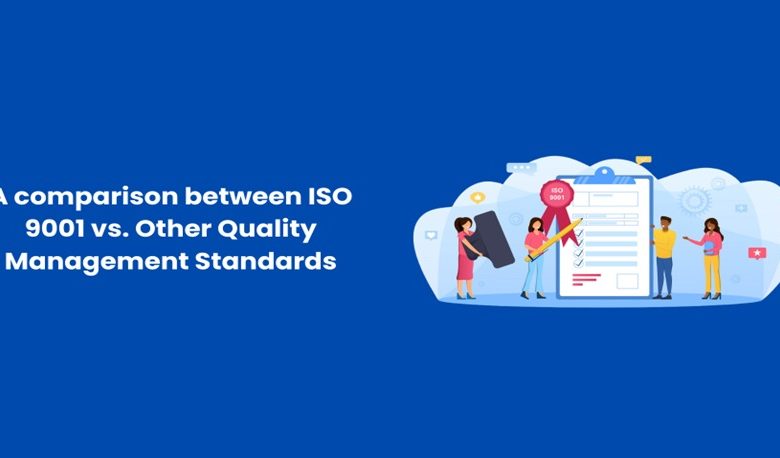A Comparison between ISO 9001 vs. Other Quality Management Standards

Sustaining superior goods and services is essential for business success. The application of Quality Management Standards results from this dedication to quality. Of all these standards, ISO 9001 is the most accepted and ISO 9001 Training has wide recognition in the industry. We will examine the field of quality management and perform a thorough analysis of ISO 9001 vs. other quality management standards in this blog. Before we get into the comparison, let’s start with a quick summary of “What is ISO 9001?” and its importance in the current corporate environment.
Table of contents
- What is ISO 9001?
- ISO 9001 vs. Other Quality Management Standards
- ISO 14001 – Environmental Management System (EMS)
- ISO 45001 – Occupational Health and Safety Management System (OHSMS)
- ISO 27001 – Information Security Management System (ISMS)
- ISO 13485 – Medical Devices Quality Management System (QMS)
- Six Sigma
- Total Quality Management (TQM)
- Conclusion
What is ISO 9001?
An organised method for raising the calibre of goods and services a company provides is ISO 9001 training. It is a thorough Quality Management System (QMS) that prioritises customer pleasure, ongoing improvement, and adherence to legal obligations. It is more than just a collection of regulations. The International Organisation for Standardisation (ISO) created and maintained ISO 9001, which is appropriate for businesses of all sizes and sectors.
The fundamental principles of ISO 9001 include relationship management, evidence-based decision-making, leadership, employee involvement, process approach, improvement, and customer focus. These guidelines are the cornerstone for creating a strong quality management system that promotes an organisation-wide culture of excellence.
ISO 9001 vs. Other Quality Management Standards
Let’s investigate the differences between ISO 9001 and other quality management standards.
ISO 14001 – Environmental Management System (EMS):
An emphasis of ISO 14001 is environmental management. ISO 14001 places more emphasis on environmental sustainability than ISO 9001 does on the quality of products and services. Businesses that prioritise environmental responsibility frequently select ISO 14001 in addition to ISO 9001 to ensure they adhere to environmental and quality standards. By integrating these two standards, organisations may simultaneously manage their quality and environmental goals more effectively.
ISO 45001 – Occupational Health and Safety Management System (OHSMS):
Safety is a top priority in a lot of sectors. To address this, ISO 45001 offers organisations a framework for setting up a functional occupational health and safety management system. While its primary focus is safety, ISO 45001 can be used with ISO 9001. Organisations may ensure that issues related to quality, safety, and the environment are fully handled by incorporating these standards.
ISO 27001 – Information Security Management System (ISMS):
One of an organisation’s main priorities is data security. ISO 27001 outlines a systematic approach to sensitive information protection and management. Although it might not seem connected to quality management, ISO 27001 and ISO 9001 can be combined to guarantee data security is upheld while providing high-calibre goods and services. Particularly in sectors handling sensitive consumer data, this integration aids businesses in finding a balance between security and quality.
ISO 13485 – Medical Devices Quality Management System (QMS):
The industry standard for companies that manufacture medical equipment is ISO 13485. It is especially concerned with guaranteeing the calibre and safety of medical equipment. While ISO 9001 covers a wider range of industries, ISO 13485 offers particular recommendations for the medical device industry. Notwithstanding, establishments can combine ISO 13485 and ISO 9001 to preserve a comprehensive quality control system.
Six Sigma:
Six Sigma is a data-driven methodology designed to enhance processes and eliminate errors. In contrast to ISO 9001, a standard, Six Sigma is a collection of methods and resources for enhancing processes. Although Six Sigma is not a substitute for ISO 9001, it is frequently used in conjunction with it by organisations to improve their quality management initiatives. With its emphasis on statistical analysis and process optimisation, Six Sigma enhances ISO 9001’s continuous improvement concepts.
Total Quality Management (TQM):
An organisation’s entire workforce is involved in the comprehensive approach to quality, known as total quality management. It strongly emphasises ongoing improvement, staff involvement, and customer happiness. TQM can be used with ISO 9001 principles to establish a quality culture inside an organisation, even if it is not a formal standard like ISO 9001. TQM complements ISO 9001’s customer-focused methodology and improvement-focused approach perfectly.
Conclusion
The ISO 9001 standard is a flexible and well-recognised framework. It is imperative to acknowledge that ISO 9001 is not the sole alternative. Other quality management standards like ISO 14001, ISO 45001, ISO 27001, ISO 13485, Six Sigma, and Total Quality Management may also be crucial in guaranteeing overall quality and compliance, depending on an organisation’s industry and particular aims. For more information, check this page out:The Knowledge Academy.
Apart from that if you want to know about A Comparison between ISO 9001 vs. Other Quality Management Standards then visit our Office category.
